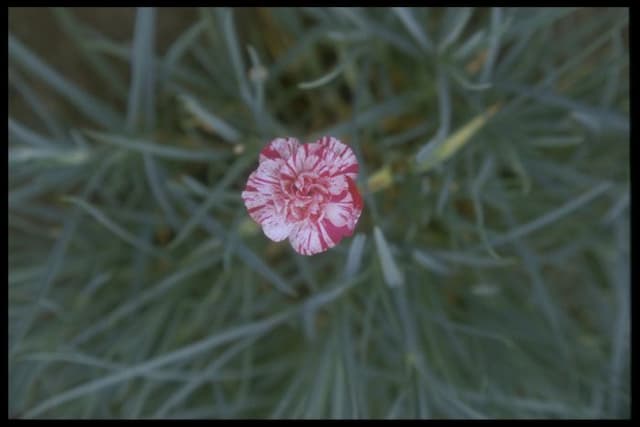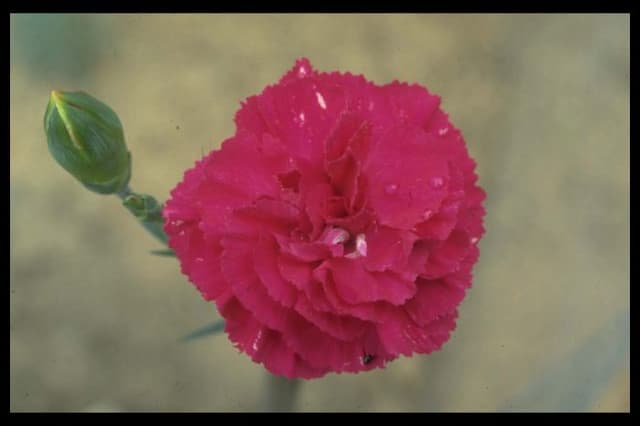Baby's breath Gypsophila elegans

ABOUT
Gypsophila elegans, commonly known as baby's breath, is a delicate and airy plant known for its profuse clusters of small, usually white or pale pink flowers. Each flower is petite and has a rounded overall shape with thin, branching stems that create a misty effect. Baby's breath blooms consist of five petals, often with a frilled or slightly notched edge, that form a shallow cup around the central reproductive parts. The plant's foliage is composed of narrow, lance-shaped leaves that are a light green color, contributing to its overall feathery and ethereal appearance. With its cloud-like floral displays, baby's breath is often used as a filler in floral arrangements, adding a light, whimsical touch to bouquets and decorations.
About this plant
 Names
NamesFamily
Caryophyllaceae
Synonyms
Baby's Breath, Showy Baby's-breath, Annual Baby's-breath, Maiden's Breath
Common names
Gypsophila muralis, Gypsophila paniculata var. elegans.
 Toxicity
ToxicityTo humans
Baby's breath, the common name for Gypsophila elegans, is not considered toxic to humans. Ingesting parts of this plant is not generally known to cause poisoning or serious harm in people.
To pets
Baby's breath may cause mild gastrointestinal upset in pets if ingested, but it is not considered highly toxic. Symptoms might include vomiting or diarrhea, but serious poisoning is not typically associated with this plant.
 Characteristics
CharacteristicsLife cycle
Annuals
Foliage type
Deciduous
Color of leaves
Green
Flower color
White
Height
1-2 feet (30-60 cm)
Spread
1-2 feet (30-60 cm)
Plant type
Herb
Hardiness zones
3-7
Native area
Eastern Europe
Benefits
 General Benefits
General Benefits- Aesthetic Appeal: Gypsophila elegans, commonly known as Baby's-breath, adds delicate beauty to gardens and floral arrangements with its small, white, cloud-like blooms.
- Low Maintenance: Baby's-breath is drought-tolerant and generally easy to care for, requiring minimal attention once established.
- Attracts Beneficial Insects: The flowers provide nectar that attracts pollinators like bees and butterflies, supporting the local ecosystem.
- Favorable Growth: Baby's-breath has a fast growth rate, quickly filling in garden spaces and providing a sense of fullness.
- Soil Adaptation: This plant can adapt to a variety of soil types, although it prefers well-drained, alkaline soils.
- Versatility in Landscaping: It can be used in rock gardens, borders, and as a companion plant, providing contrast and complementing other plants.
- Long Blooming Period: Baby's-breath typically enjoys a long flowering period, ensuring garden color and interest for a good part of the growing season.
- Coverage: The plant serves as effective ground cover, suppressing weeds and reducing garden maintenance.
- Cut Flowers: The blooms last well when cut and are a staple in floristry for adding texture and volume to bouquets and centerpieces.
- Event Decor: Due to their delicate appearance and association with purity and love, they are popular for weddings and other celebrations.
 Medical Properties
Medical PropertiesThis plant is not used for medical purposes.
 Air-purifying Qualities
Air-purifying QualitiesThis plant is not specifically known for air purifying qualities.
 Other Uses
Other Uses- Gypsophila elegans, commonly known as baby's breath, is often used in the creation of natural dyes, with its roots and flowers yielding subtle hues for fabrics.
- This plant acts as a companion plant in gardens by attracting pollinators that benefit surrounding plants or by deterring pests due to its distinct aroma.
- The dried stems and flowers of baby's breath are used in potpourri mixes, providing a delicate texture and an aesthetic appeal to the mixture.
- Artists and crafters incorporate dried baby's breath into papermaking to add organic elements and texture to handmade paper products.
- Baby's breath is used in landscaping as ground cover to provide a blanket of tiny blooms that can minimize soil erosion and suppress weed growth.
- In culinary arts, baby's breath is occasionally used as a decorative and edible garnish on cakes and desserts for its delicate structure.
- The plant can serve as a natural indicator of soil pH, with certain growth patterns suggesting acidic or alkaline conditions, useful for gardeners.
- Baby's breath is integrated into homemade natural insect repellents as the delicate flowers can be infused with other deterrents.
- Due to its fine branching pattern, baby's breath is used as a model or framework in floral design classes teaching intricate arrangement techniques.
- During winter holidays, baby's breath is often spray-painted in metallic colors to create festive wreaths and decorations.
Interesting Facts
 Feng Shui
Feng ShuiBaby's breath is not used in Feng Shui practice.
 Zodiac Sign Compitability
Zodiac Sign CompitabilityBaby's breath is not used in astrology practice.
 Plant Symbolism
Plant Symbolism- Innocence: Often due to its delicate and dainty blooms, Gypsophila, commonly known as Baby's Breath, symbolizes purity and innocence, making it a popular choice for christenings and weddings.
- Lasting Love: Baby's Breath is commonly used in bridal bouquets and wedding decorations to represent enduring love, because it retains its beauty for a long time even after being cut.
- Pure Heart: The pure white color of the flowers is frequently associated with a pure heart or intentions.
- Festivity: Because Baby's Breath is often used in joyful celebrations, it has become a symbol of festivity.
- Companionship: The way the tiny flowers cluster together on each stem symbolizes unity and support, making them stand for the close bonds of friendship or companionship.
 Water
WaterBaby's breath requires moderate watering, and it's best to water when the top inch of soil feels dry to the touch. Generally, this could be once a week, but frequency may vary depending on climate and weather conditions. Provide enough water to moisten the soil without causing standing water. When watering, use approximately 1 gallon per square yard per week during the growing season, adjusting as needed based on rainfall and temperature. Avoid overhead watering to prevent fungal diseases; instead, water at ground level.
 Light
LightBaby's breath thrives in full sun, so you should place it in a location where it will receive at least 6 to 8 hours of direct sunlight daily. An east or south-facing spot that enjoys the morning and afternoon sun is ideal. Adequate sunlight is crucial for the development of the dense, delicate blooms that baby's breath is known for.
 Temperature
TemperatureBaby's breath does well in a range of temperatures but prefers cooler conditions and grows best between 60°F and 70°F. The plant can tolerate temperatures as low as 40°F and survive short periods of frost, but it should be protected from prolonged exposure to temperatures below this range. Excessively high temperatures above 80°F may inhibit blooming.
 Pruning
PruningPrune baby's breath to maintain its shape, encourage bushier growth, and enhance flowering. Deadheading, or removing faded flowers, can promote a second bloom. Cut back the plant by one-third after the first bloom is over, typically in midsummer, to tidy the plant and potentially encourage new flowers. Pruning is also an opportunity to remove any dead or diseased stems.
 Cleaning
CleaningAs needed
 Soil
SoilBaby's breath (Gypsophila elegans) thrives in well-draining, sandy or loamy soil with a pH around 7.0 (neutral). A good soil mix can be created with equal parts garden soil, sand, and peat for optimal growth and root aeration. It is crucial to avoid waterlogged soils to prevent root rot.
 Repotting
RepottingBaby's breath (Gypsophila elegans) rarely needs repotting as it is often grown as an annual. If grown as a perennial, repotting can be done every 2-3 years to refresh the soil and accommodate root growth.
 Humidity & Misting
Humidity & MistingBaby's breath (Gypsophila elegans) prefers relatively low humidity levels, typical of arid or semi-arid climates. Excessive humidity can lead to fungal diseases, so ensure good air circulation if grown in more humid conditions.
 Suitable locations
Suitable locationsIndoor
Place Baby's breath (Gypsophila elegans) in bright, indirect light indoors.
Outdoor
Plant Baby's breath (Gypsophila elegans) in full sun with good air flow.
Hardiness zone
3-7 USDA
 Life cycle
Life cycleGypsophila elegans, commonly known as annual baby's breath, begins its life as a seed which germinates in early spring when the soil has warmed. Seedlings emerge and grow rapidly, quickly forming a rosette of narrow, lance-shaped leaves. As it matures, Gypsophila elegans develops slender, branching stems that reach up to 18-30 inches tall, upon which clusters of small, white or pinkish flowers bloom in late spring to summer. Following pollination, typically by bees or other insects, the plant sets seed in a capsule that eventually dries and splits open to release its seeds. The plant completes its life cycle within one growing season, dying after seed dispersal. To perpetuate the species, the released seeds will remain dormant until the following spring, when they are ready to germinate and start the life cycle anew.
 Propogation
PropogationPropogation time
Spring to early summer
Baby's breath, or Gypsophila elegans, is most commonly propagated through seeds. The best time to sow Baby's Breath seeds is in the spring after the last frost when the soil has warmed up. Seeds should be scattered thinly onto well-drained soil and lightly pressed in, but not covered, as they need light to germinate. Keep the soil moist until germination, which typically occurs within 10 to 20 days. Once seedlings emerge and have a few true leaves, thin them to stand about 8 to 12 inches apart, allowing each plant ample space to grow. Baby's breath can also be direct sown into the garden where they will grow once the soil temperature has reached about 70 degrees Fahrenheit (21 degrees Celsius). This method is favored for its simplicity and effectiveness in producing large quantities of the delicate, airy blooms for which baby's breath is known.









